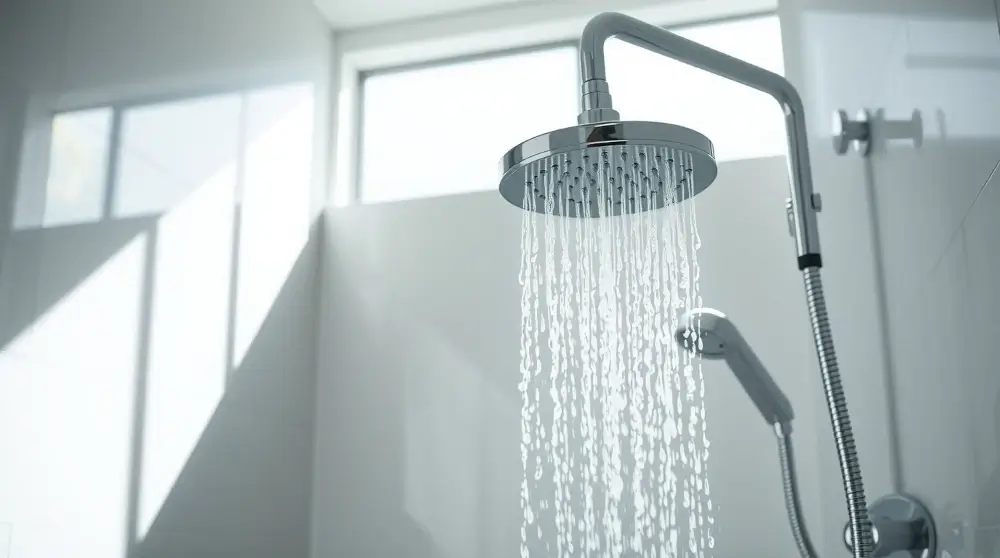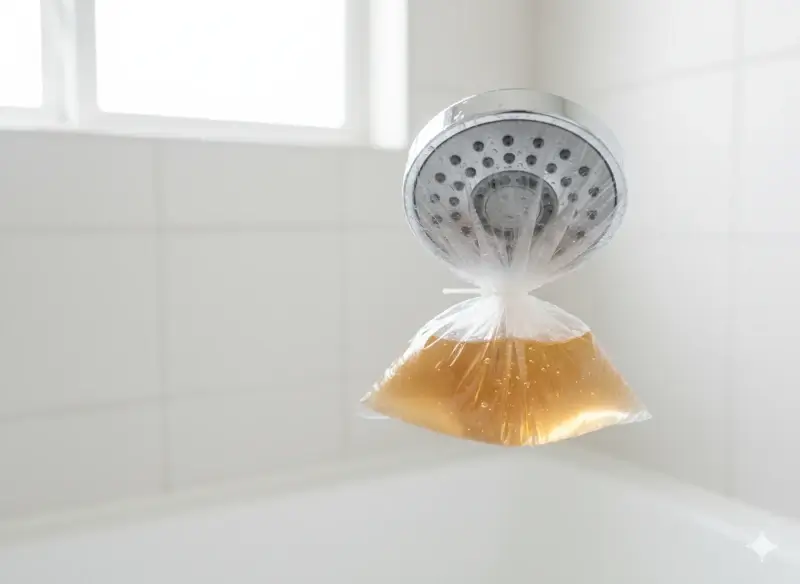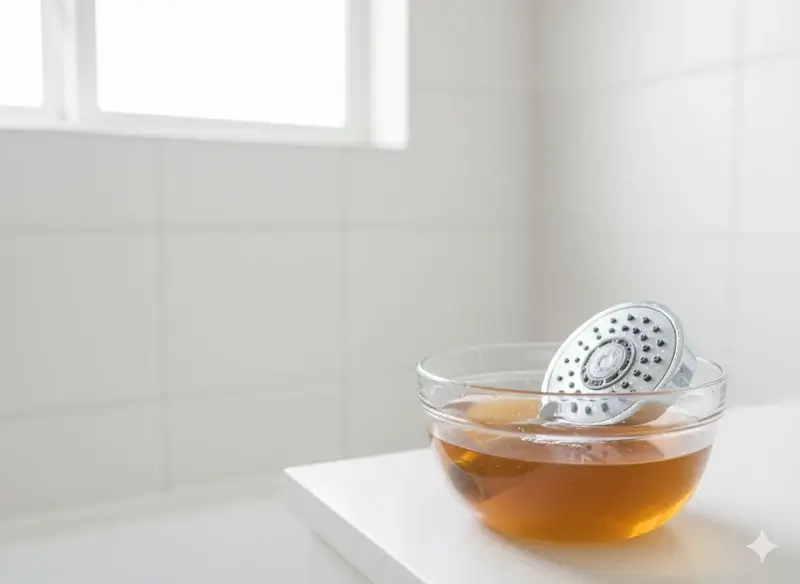
Ever turned on your shower expecting a refreshing spray, only to get a weak drizzle? Instead of a relaxing shower, you’re left shivering under a few sad streams of water. In most cases, the problem isn’t your plumbing—it’s your shower head.
Over time, minerals like calcium and limescale build up inside the tiny nozzles, especially if you live in a hard water area. They clog the spray holes, reduce water pressure, and sometimes even cause water to shoot out in strange directions.
I’ve been there too. At one point, I thought my pipes were damaged because the water pressure dropped dramatically. When I finally took off the shower head, I found it crusted with white deposits. A simple vinegar soak later, it felt like I had a brand-new shower.
The truth is: descaling your shower head is simple, inexpensive, and makes a big difference. Here’s how to do it step by step.
👉 For complete bathroom routines, see our Bathroom Cleaning Master Guide.
Why Shower Heads Get Clogged with Limescale
- Hard water minerals. Areas with high calcium/magnesium leave deposits behind.
- Daily steam. Warm mist accelerates buildup.
- Neglected cleaning. Few people think to clean their shower heads, so deposits accumulate for months.
- Bacteria growth. Damp buildup creates an environment where bacteria thrive.
💡 Think of your shower head like a coffee maker—without descaling, it clogs and performance suffers.
How Often Should You Descale?
- Hard water areas: every 2–3 months.
- Normal water: every 6 months.
- Quick maintenance: a weekly wipe keeps buildup from forming.
If you notice water spraying sideways or reduced pressure, that’s your sign it’s time to clean.
Supplies You’ll Need
- White vinegar.
- Plastic bag (ziplock or sturdy).
- Rubber band or twist tie.
- Old toothbrush.
- Microfiber cloth.
- Optional: baking soda, lemon juice, or commercial descaler.
👉 See our Best Bathroom Cleaning Supplies & Tools for top picks.
Step-by-Step: How to Descale a Shower Head
Method 1: Vinegar Bag Soak (No Removal Needed)

- Fill a plastic bag with vinegar (enough to submerge the head).
- Place bag over shower head, secure with rubber band.
- Let soak 1–2 hours (overnight if buildup is heavy).
- Remove bag, scrub gently with toothbrush.
- Run hot water for 1 minute to flush out deposits.
💡 Bonus: Add 1 spoon of baking soda to vinegar—the fizz helps loosen limescale.
Method 2: Full Removal for Deep Clean

- Unscrew shower head from pipe (wrap cloth around wrench to avoid scratches).
- Place parts in bowl of vinegar.
- Let soak 2–4 hours.
- Scrub inside and nozzle holes with toothbrush.
- Rinse and reattach.
👉 Pro tip: If your shower head has removable parts, disassemble them for thorough cleaning.
Method 3: Quick Maintenance Wipe
- Dampen microfiber cloth with vinegar.
- Wipe shower head surface weekly.
- Prevents buildup before it hardens.
This 1-minute habit saves hours of scrubbing later.
Natural vs. Chemical Descaling
Natural Cleaners (Vinegar, Lemon, Baking Soda)
✅ Eco-friendly.
✅ Cheap & available at home.
✅ Gentle on most finishes.
❌ Takes longer for very heavy buildup.
Chemical Descalers
✅ Very effective for thick limescale.
✅ Works faster (30–60 minutes).
❌ Strong odor & chemicals.
❌ Can corrode metal or damage coating if overused.
👉 If you prefer natural methods, check our Eco-Friendly Bathroom Cleaning Tips.
When to Replace Instead of Clean
Sometimes cleaning isn’t enough. Replace your shower head if:
- The water pressure stays weak after descaling.
- The nozzles are permanently damaged or cracked.
- Rust is visible inside.
- It hasn’t been replaced in over 5–7 years.
💡 A new shower head can also save water—modern models use less water but provide stronger spray.
Preventing Future Buildup
- Wipe shower head after use.
- Run hot water for 1 minute weekly to flush deposits.
- Use water softener if you live in hard water area.
- Choose a shower head with rubber nozzles (easy to clean).
👉 Add this to your Bathroom Cleaning Checklist routine.
Common Mistakes to Avoid
- Soaking chrome shower head in vinegar too long → can dull finish.
- Using bleach → corrodes metal and rubber.
- Scrubbing with steel wool → scratches the surface.
- Forgetting to flush water after soaking → leaves vinegar taste in first spray.
FAQs
Q: Can vinegar damage my shower head?
No, as long as you don’t soak for more than 12 hours.
Q: Is lemon juice as effective as vinegar?
Yes for light buildup, but vinegar works better for heavy deposits.
Q: Can I descale a handheld shower head?
Yes, simply detach and soak it in a bowl of vinegar.
Q: How do I descale without vinegar smell?
Add a few drops of lemon or essential oils.
Q: Quick fix before guests arrive?
Do a 30-minute vinegar soak, then rinse with hot water.
Closing
A clogged shower head doesn’t mean expensive repairs—it just needs a little TLC. With vinegar, a toothbrush, and 30 minutes, you can restore strong water flow and extend its life.
The secret is consistency: quick wipes weekly, deep soaks every few months. Trust me, the difference in your daily shower is worth it.
👉 Upgrade your full bathroom care with our Bathroom Cleaning Master Guide.
